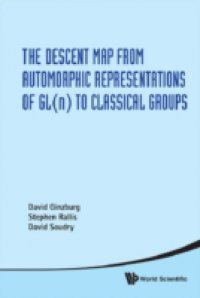This book introduces the method of automorphic descent, providing an explicit inverse map to the (weak) Langlands functorial lift from generic, cuspidal representations on classical groups to general linear groups. The essence of this method is the study of certain Fourier coefficients of Gelfand–Graev type, or of Fourier–Jacobi type when applied to certain residual Eisenstein series. This book contains a complete account of this automorphic descent, with complete, detailed proofs. The book will be of interest to graduate students and mathematicians, who specialize in automorphic forms and in representation theory of reductive groups over local fields. Relatively self-contained, the content of some of the chapters can serve as topics for graduate students seminars.Contents:Introduction:OverviewFormulas for the Weil representationThe case, where H is unitary and the place ν splits in EOn Certain Residual Representations:The groupsThe Eisenstein series to be consideredL-groups and representations related to PφThe residue representationThe case of a maximal parabolic subgroup (r = 1)A preliminary lemma on Eisenstein series on GLnConstant terms of E(h, ƒτ,$bar s$)Description of W(Mφ,Dk)Continuation of the proof of Theorem 2.1Coefficients of Gelfand-Graev Type, of Fourier-Jacobi Type, and Descent:Gelfand-Graev coefficientsFourier-Jacobi coefficientsNilpotent orbitsGlobal integrals representing L-functions IGlobal integrals representing L-functions IIDefinition of the descentDefinition of Jacquet modules corresponding to Gelfand-Graev charactersDefinition of Jacquet modules corresponding to Fourier-Jacobi charactersSome double coset decompositions:The space Qjh(V)k/QℓA set of representatives for Qjh(V)k/QℓStabilizersThe set Qh(Wm,ℓ)k/Lℓ,ω0Jacquet modules of parabolic inductions: Gelfand-Graev characters:The case where K is a fieldThe case K = k ⊕ kJacquet modules of parabolic inductions: Fourier-Jacobi characters:The case where K is a fieldThe case K = k ⊕ kThe tower property:A general lemma on “exchanging roots”A formula for constant terms of Gelfand-Graev coefficientsGlobal Gelfand-Graev models for cuspidal representationsThe general case: H is neither split nor quasi-splitGlobal Gelfand-Graev models for the residual representations E$bar τ$A formula for constant terms of Fourier-Jacobi coefficientsGlobal Fourier-Jacobi models for cuspidal representationsGlobal Fourier-Jacobi models for the residual representations E$bar τ$Non-vanishing of the descent I:The Fourier coefficient corresponding to the partition (m,m,m′ — 2m)Conjugation of Sm by the element αmExchanging the roots y1,2 and x1,1 (dimEV = 2m , m > 2)First induction step: exchanging the roots yi,j and xj–1,i, for 1 ≤ i < j ≤ $[frac{m+1}{2}]$; dimEV = 2mFirst induction step: odd orthogonal groupsSecond induction step: exchanging the roots y1,2 and xj–1,i, for i + j ≤ m+ 1, j > $[frac{m+1}{2}]$ (dimEV = 2m)Completion of the proof of Theorems 8.1, 8.2; dimEV = 2mCompletion of the proof of Theorem 8.3Second induction step: odd orthogonal groupsCompletion of the proof of Theorems 8.1, 8.2; h(V) odd orthogonalNon-vanishing of the descent II:The case HA = $widetilde{rm Sp}$4n+2(A)The case H = SO4n+2Whittaker coefficients of the descent corresponding to Gelfand-Graev coefficients: the unipotent group and its character; h(V) ≠ SO4n+2Conjugation by the element $hat{eta}m$Exchanging roots: h(V) = SO4n, U4nNonvanishing of the Whittaker coefficient of the descent corresponding to Gelfand-Graev coefficients: SO4n, U4nNonvanishing of the Whittaker coefficient of the descent corresponding to Gelfand-Graev coefficients: h(V) = U4n+2, SO4n+3The Whittaker coefficient of the descent corresponding to Fourier-Jacobi coefficients: HA ≠ $widetilde{rm Sp}$4n+2(A)The nonvanishing of the Whittaker coefficient of the descent corresponding to Fourier-Jacobi coefficients: HA = Sp4n(A),$widetilde{rm Sp}$4n(A), U4n(A)Nonvanishing of the Whittaker coefficient of the descent corresponding to Fourier-Jacobi coefficients: h(V) = U4n+2Global genericity of the descent and global integrals:Statement of the theoremsProof of Theorem 10.3Proof of Theorem 10.4A family of dual global integrals IA family of dual global integrals IIL-functionsNon-vanishing of the descent II:The cuspidal part of the weak liftThe image of the weak liftOn generalized endoscopyBase changeAutomorphic inductionReadership: Graduate students and mathematicians in algebra and number theory.



 9.75 (4)
9.75 (4) 














